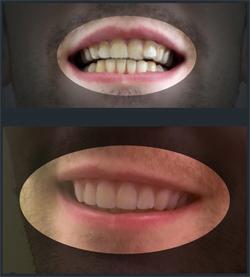Paying for orthodontia to straighten your teeth or your kids’ teeth can be extremely expensive, but what else can you do if your teeth are all crooked? Well: One college student used a 3-D printer to create clear retainers that corrected his snaggletooth.
Amos Dudley wore retainers he had made day and night for 16 weeks, and his teeth are looking good! Dudley, who is studying digital design at the New Jersey Institute of Technology, took advantage of the high quality equipment at his school to do the project. First he made a mold of his teeth using alginate gel and then cast his teeth in Permastone, a compound that dries solid and smooth. Then he used a NextEngine laser scanner to digitize the cast in three dimensions. Once he had the digital version of his teeth, Dudley used information from orthodontia textbooks to decide how and where to tweak the digital teeth so the resulting retainers would be corrective instead of just a perfect fit to his existing mouth.
“Here’s where it started to get very exciting,” he wrote in a blog post published Thursday. Once Dudley had the plan for how he was going to correct his crooked teeth, he used a very accurate 3-D printer to print solid versions of how he wanted his teeth to look. Finally he used the 3-D–printed models of his mouth as the mold to shape heated sheets of inert retainer plastic in a vacuum forming machine.

Amos Dudley
One other thing he wrote in that blog post: “Warning: Do not attempt anything written here.” It’s the Internet, though, so we’ll see how long that lasts.
Dudley told Slate that he only spent about $60 on materials, but he points out that of course it wouldn’t have been so cheap if he hadn’t had access to expensive equipment through his school. He wrote, “I’m an undergrad, which means that a) I’m broke, and b) I have access to expensive digital fabrication tools—definitely an unusual dichotomy.”
Dudley’s project still has interesting implications for the potential democratization of orthodontia. Chris Woolaver, who runs the biggest Invisalign practice in Arizona, told New York magazine in June that, “I’m a banker, and I never wanted to be a banker,” referring to the payment plans most patients are on to pay for treatment. The article called orthodontia “a capitalistic parable.”
It’s not hard to imagine orthodontia startups disrupting the industry and drastically lowering the price of appliances like retainers. Dudley’s process would be especially inexpensive for something simple like a nightguard that reduces grinding and simply mimics the mold of your teeth as they are. But true DIY just doesn’t seem like a good idea no matter whose 3-D printer you can borrow. Homemade retainers worked for Dudley, but the process wouldn’t work for everyone and could even be dangerous, as he readily admits. He explained to Slate, “I’ve had orthodontists tell me ‘This is great but I wouldn’t do this in a thousand years.’ “
